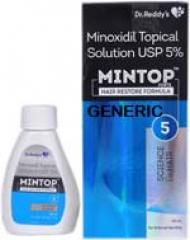What happens when you use Minoxidil for Hairloss?
Minoxidil is a medical drug solution available to us under the generic name Rogaine which belongs to a class of medication called Vasodilators. This medicine is used to treat pattern hair loss, unexplained hair loss or patchy hair loss in men. It generally works by widening the blood vessels so that more high rich oxygen blood could reach to the hair follicles. It is also used orally for treatment of severe hypertension.

This medicine should not be used if you have sudden/patchy hair loss, unexplained hair loss (no history of hair loss). Also, if you suffer hair loss after delivering birth. If you are under the age of 18, do not use this product.
When and how to use Minoxidil?
Before using this product, read and abide by all instructions on the product packaging. Ask your physician or pharmacist if you have any queries.
Before using the drug, thoroughly clean and dry the scalp area. You can use damp hair to apply this product. To use the solution, add 20 drops or 1 millilitre of medication to the applicator (up to the 1 millilitre line). Apply the solution evenly to the affected area of the scalp by parting your hair in the area where it is thinning. Rub in gently. Before applying additional styling products (such gels or mousse) or before retiring to bed, let the solution completely dry.
Benefits of Minoxidil for Hair
Whatever its mechanism of action, minoxidil can be extremely helpful for people who have hair loss or thinning hair.
- Encourages hair development: According to Samantha Fisher, MD, a dermatologist in Florida, “Minoxidil is a topical drug that is given to the scalp to encourage new hair growth in patients experiencing hair loss.”
- Increases hair density and thickness: According to Fisher, minoxidil can thicken and increase the density of hair in addition to promoting hair growth and stopping a receding hairline. In other words, the strands regrow stronger and fuller.
- Treats hair disorder: Minoxidil has been demonstrated to be beneficial in treating androgenetic alopecia and female pattern hair loss patients by boosting hair regeneration and density.
Rogaine for Men
- Male pattern baldness can be effectively treated with rogaine to promote hair growth. In a previous study from 2002, it was discovered that participants who used topical minoxidil at a concentration of 5% saw effects more quickly and had 45% more hair sprout over the course of 48 weeks.
- The study’s researchers also discovered that study participants who took topical minoxidil at a concentration of 5 percent had improved “psychosocial views” of hair loss.
Rogaine for Women
- Women can also benefit from Rogaine. A previous study from 2004 found that topical minoxidil at 5% was superior to topical minoxidil at 2%.
- 48 weeks were spent on the trial, and both the 5% and 2% versions aided in enhancing psychological impressions of hair loss in female pattern hair loss sufferers.
- Rogaine is not advised for use by women who are nursing or expecting.
Side effects of Minoxidil.
Common side effects observed while medicating with Minoxidil are stinging, burning or redness may occur. Inform your doctor if these conditions persist or get worse.
There are some rare serious side effects which must be informed to the doctor right away if observed such as unwanted facial/body hair, dizziness, fast/irregular heartbeat, fainting, chest pain, swelling of hands/feet, unusual weight gain, tiredness, difficulty breathing especially when lying down, etc.
There are also some severe allergic reactions involved with these medications which require immediate medical attention if observed such as rash, itching/swelling (especially of the face/tongue/throat), trouble breathing, severe dizziness, etc.
Precautions before using Minoxodil
Inform your doctor or pharmacist if you have any allergies before using minoxidil, in addition to any other allergies you may have. Inactive chemicals in this product have the potential to trigger allergic reactions or other issues. To learn more, speak with your pharmacist.
Before taking this product, speak to your doctor or pharmacist if you have any of the following health issues: illnesses of the heart (chest pain, heart attack, and heart failure), kidney disease, liver disease, diseases of the scalp (eczema, infection, wounds).
This product should only be used during pregnancy if absolutely necessary. Describe the advantages and disadvantages to your doctor. It is unknown if this medication enters breast milk. Before breastfeeding, speak with your doctor.
When to see a doctor
As with other medical issues, it’s best to consult a doctor as soon as you suspect hair loss so you can begin possible therapies like Rogaine right away. Some early indications of hair loss include:
- hairline thinning
- hair that is visibly thinner
- a growing portion
- a bald patch that develops over time
- your body and face are both experiencing hair loss
Even though Rogaine is commonly accessible over the counter, it’s crucial to receive a proper diagnosis from your doctor before beginning this medicine because it isn’t suitable for all types of hair loss.
Additionally, follow up with your doctor if you are already using Rogaine and don’t see results in 4 months. To address the underlying causes of your hair loss, they might suggest a different kind of treatment.
If you suffer any possible adverse effects, such as itching, burning, or redness, stop using Rogaine and consult a doctor. These could be symptoms of irritating contact dermatitis, which is thought to be the most typical unfavourable Rogaine side effect. If you get chest pain, a fast heartbeat, or swelling in your hands or feet, get medical attention straight once.
REFERENCES:
- https://www.healthline.com/health/does-rogaine-work
- https://www.byrdie.com/minoxidil-for-hair-growth-4769934
- https://www.webmd.com/drugs/2/drug-3503/minoxidil-topical/details
- https://www.mayoclinic.org/drugs-supplements/minoxidil-topical-route/side-effects/drg-20068750?p=1
For more details, kibndly visit below.